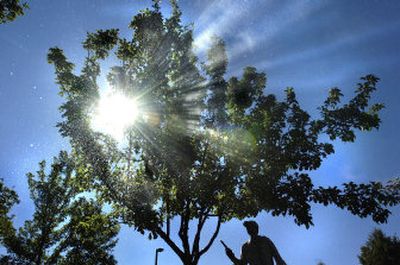Protect your trees: Learn facts before you prune

Spring is the time to stop and admire the trees and thank them for all they do. After all, they greet you with branches of cooling shade on a hot summer day.
Maybe they aren’t so great when it comes to hurricanes, but planting strong-wood trees and taking care of them reduces storm damage.
To help you responsibly care for trees in your yard, here are some myths and facts from the International Society of Arboriculture, a nonprofit professional organization of tree-care experts.
Myth: When a tree is planted, it should be staked to ensure good root development and a strong trunk.
Fact: A tree with no stakes moves a little, which actually helps it develop a stronger root system and better trunk taper. Trees in extremely windy conditions may benefit from staking for six months to a year, but no longer. The worse damage from staking is wires or ties that scar and cut into the trunk.
Myth: A newly planted tree needs tree wrap to prevent sunscald and insect injury.
Fact: Tree wrap can make temperatures worse. It does not keep out insects; in fact, some pests like to burrow under the material.
Myth: A tree should be pruned back heavily when it is planted to compensate for root loss.
Fact: A tree fares better when it has a fuller canopy of foliage to produce the much-needed food and plant hormones that induce root growth. Prune only to structurally train the tree and remove damaged, dead or diseased branches.
Myth: The final pruning cut on a branch should be flush with the stem to promote healing.
Fact: Trees compartmentalize wounds, forming wound wood over the damaged area. Flush cutting removes the “branch collar” (swelling where a branch joins the trunk), creating a larger wound than if the branch were removed outside the collar. Flush cuts promote more decay.
Myth: Pruning wounds bigger than 3 inches in diameter should be painted with a wound dressing.
Fact: Commonly used wound dressings can actually slow wound healing, and do nothing to prevent insect damage or decay.
Myth: Fast-growing, weak-wooded trees such as silver maple should be “topped” to make them stronger or less hazardous.
Fact: Topped trees may be OK — certainly ugly — at first, but they will grow and become more hazardous as time goes on. The technique stimulates twigs to grow below the cuts, causing weak attachments. Decay also spreads inside the stubs and branches that were cut.
Alternatives to topping include thinning, cabling or removal.
Better yet, take down problem trees and replace them with good species.
Myth: If certain trees are pruned early in spring, they “bleed,” stressing the tree and causing health problems.
Fact: Yes, some trees such as maples and birches “bleed,” or lose sap from spring pruning, but it does not hurt the tree. The worst time to prune a tree is just as it leafs out; the best time is during its dormancy. Flowering trees are best pruned just after they finish blooming.
Myth: A tree’s root system is a mirror image of its top.
Fact: You may envision a large, branching taproot growing deep into the soil, but taproots are uncommon in mature trees — even pines. If taproots develop, they are usually forced into horizontal growth when they encounter hard sub soils beneath the surface. The entire root systems of most trees can be found within 3 feet of soil. The root system’s spread, however, is extensive, often extending two to three times the spread of the crown (canopy of foliage).
Finally, if you hire someone to maintain your trees, make sure you get a trained arborist, not a chainsaw-outfitted driver in a pickup truck going door-to-door.
Also, get three different estimates for the job, ask for proof of insurance and never pay for the work before it’s done.